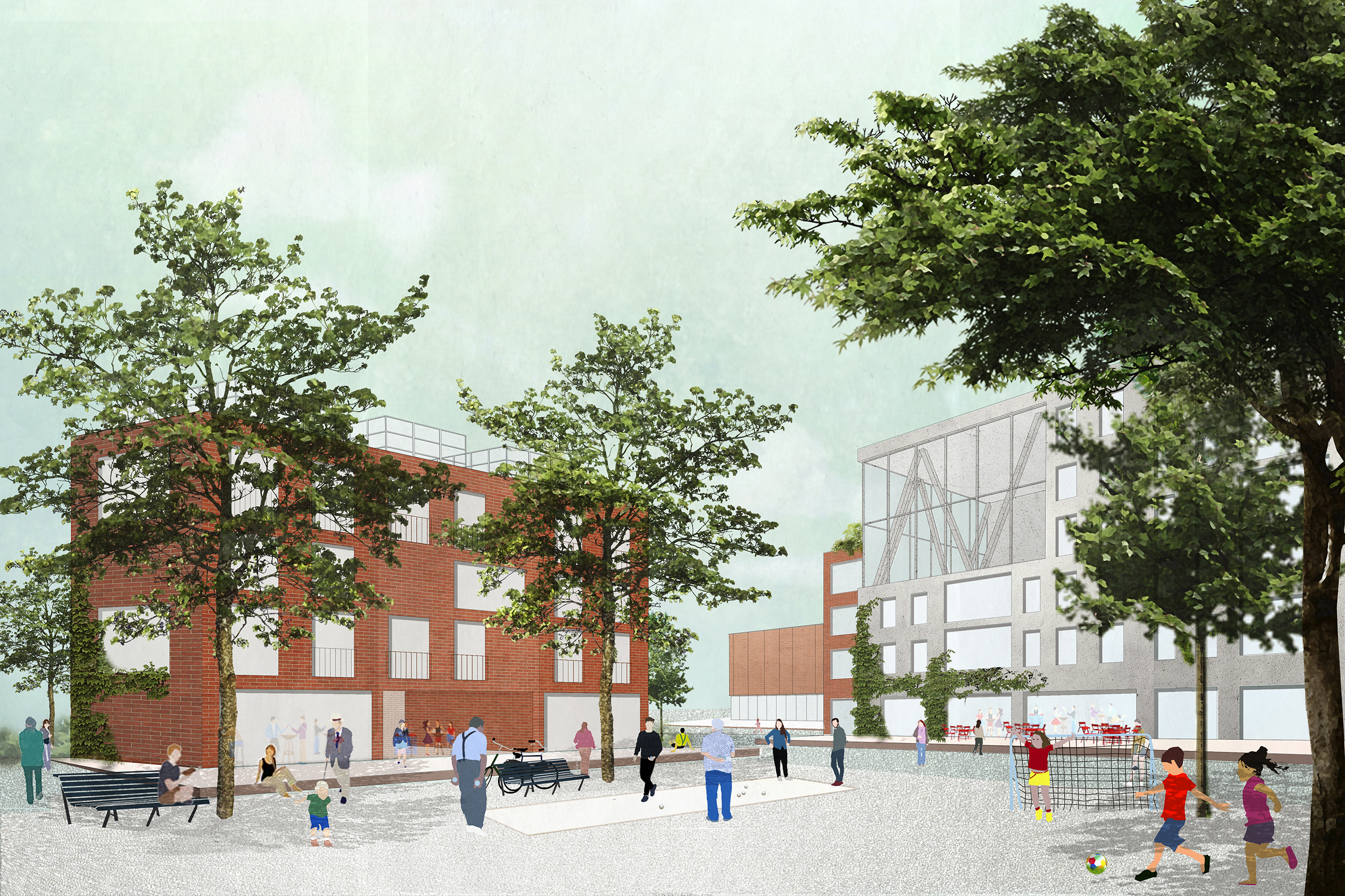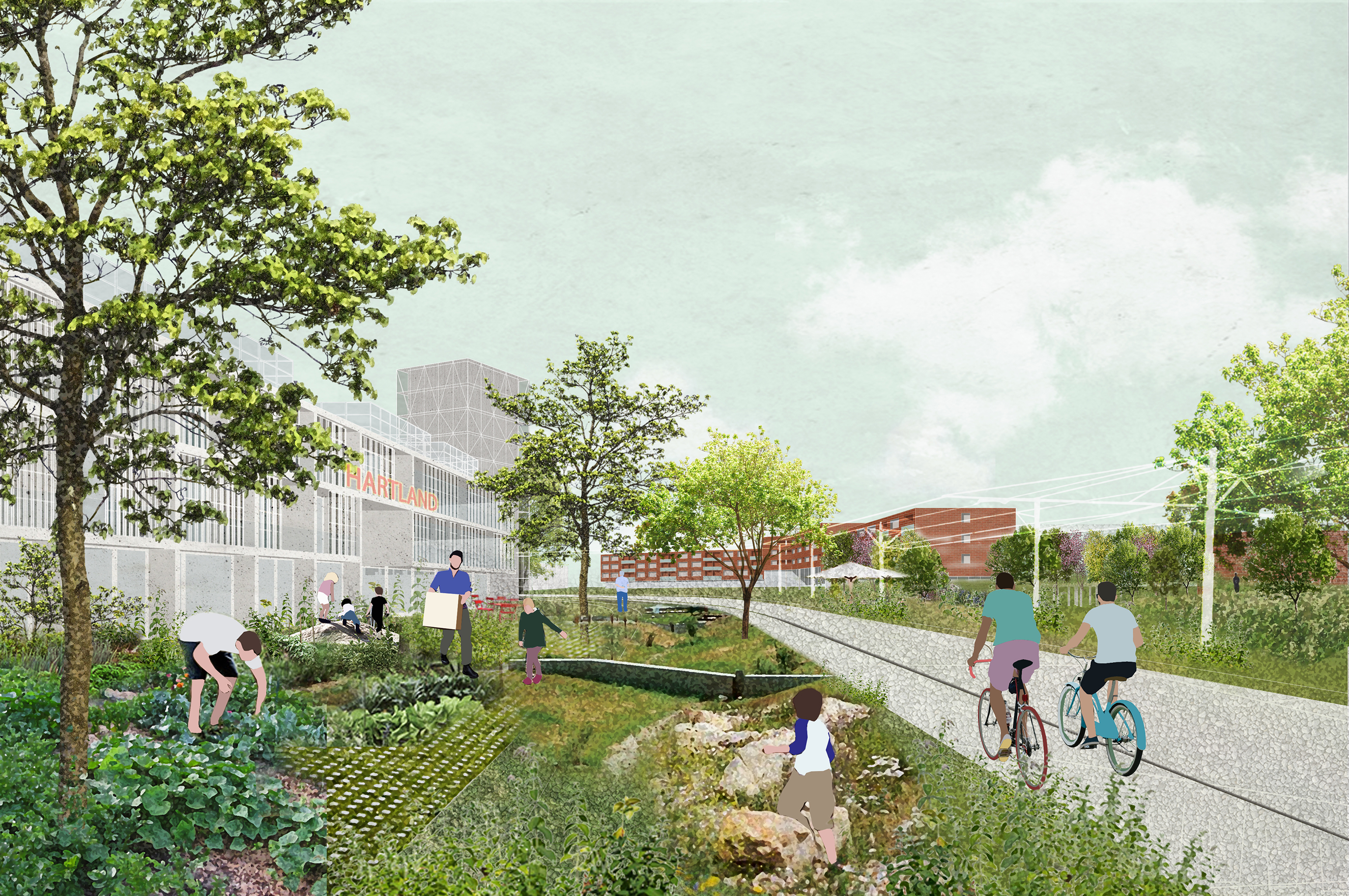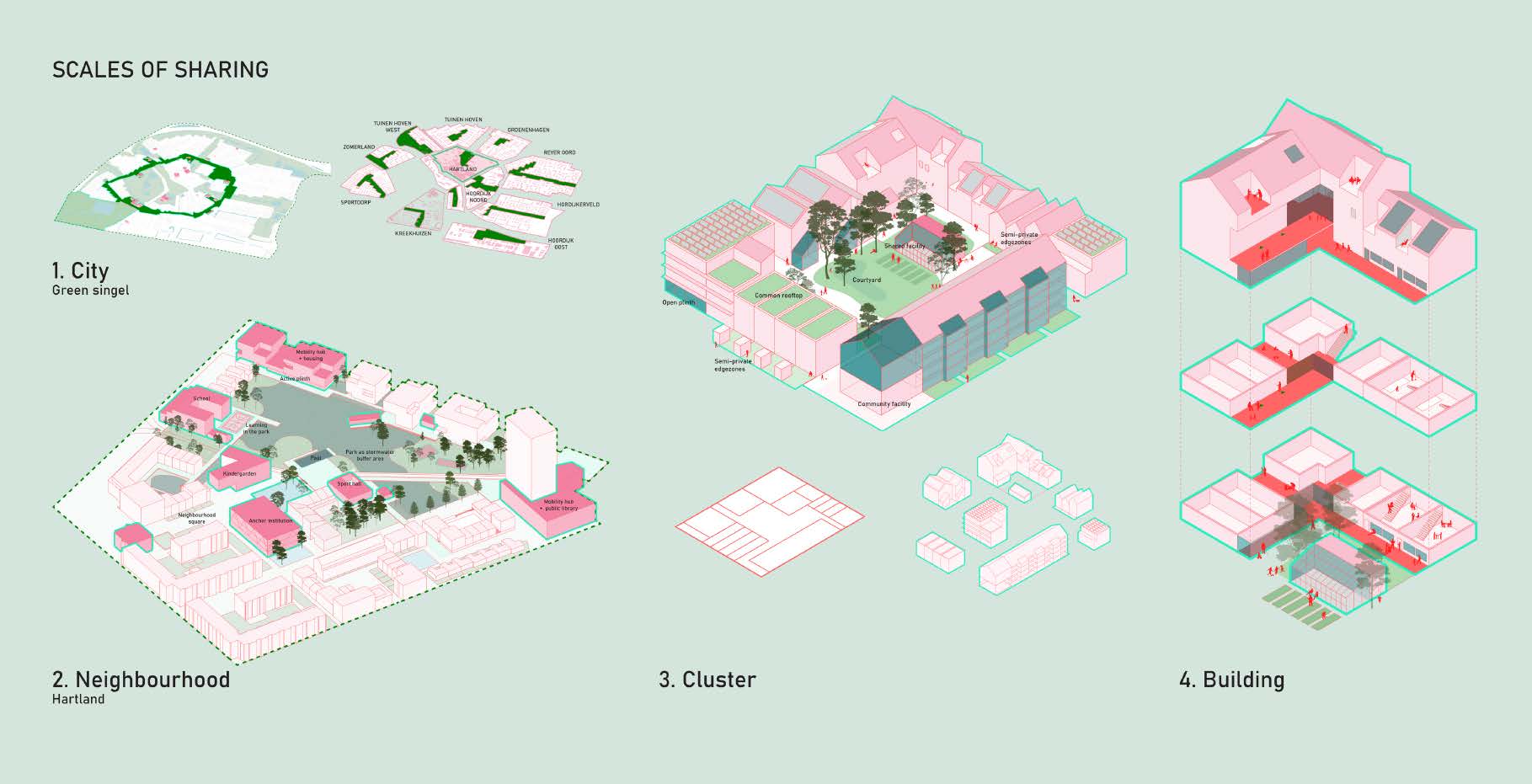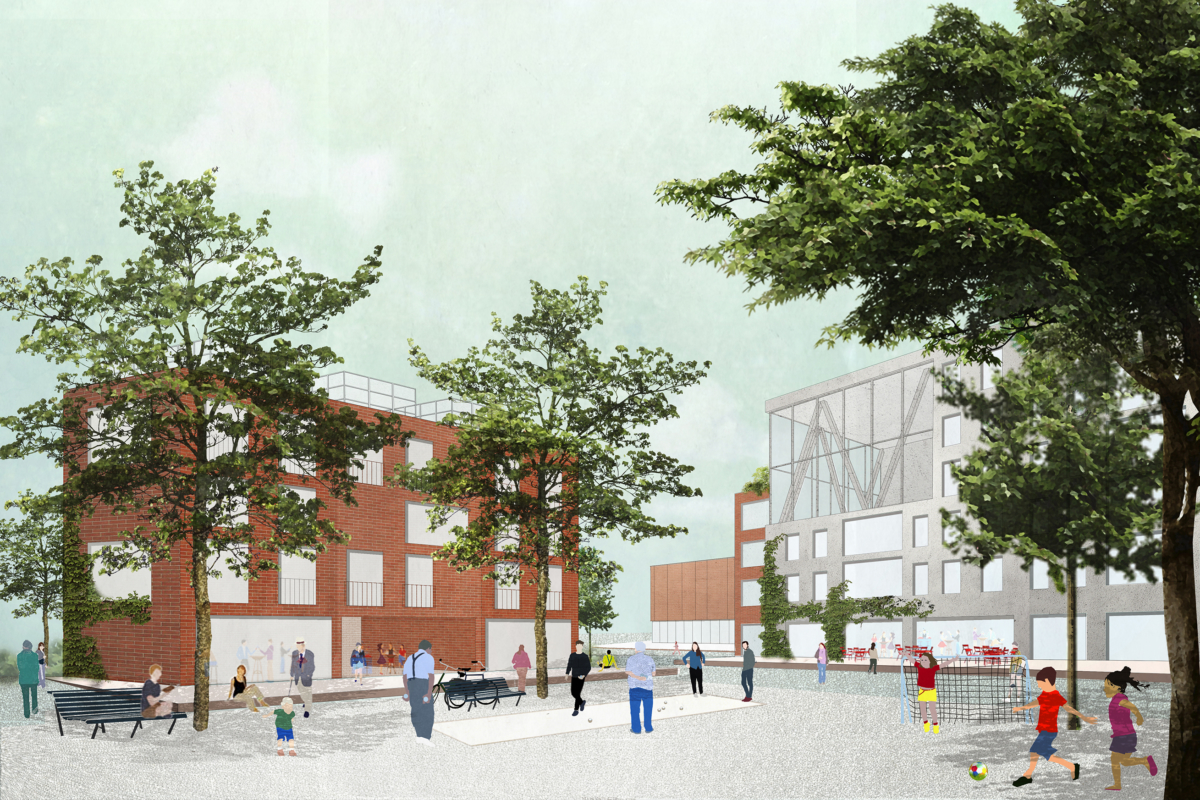Hartland: Reinventing the Garden City

Groot IJsselmonde
Collage: Hartland
Drawing inspiration from socialist and economic ideals of the original Garden City utopia, the winning proposal for Rotterdam’s Europan 15 Groot IJsselmonde site, Hartland, provides a development strategy based on principles of commons and co-creation. Different scales of sharing are translated into different spatial designs. The proposal creates a robust urban framework that accommodates socio-economic diversity in living typologies and as a result, creates opportunities for a dynamic cityscape to emerge. By adding new layers onto the existing urban framework, the proposal induces a new organisational hierarchy which strengthens the sense of community and binds the new development to its surrounding landscape. The aim of the proposed project is to create socially and naturally inclusive spaces that enable healthy life, in the Rotterdam periphery.
Hartland Team Interview
Videography: Kristel Kuiper; Interview: Cullo Studio for AIR
Groot IJsselmonde is an archetypical example of Rotterdam’s modernist planning practices. Its functional segregation, lack of spatial hierarchy, and numerous plan iterations never implemented, results in its inconsistent suburban appearance. Groot IJsselmonde not only suffers from architectural monotony and a dysfunctional centre, but also from a lack of identity and density. In light of the numerous ambitious plans for areas such as Hart van Zuid and Feyenoord city, Groot IJsselmonde is also faced with the task of reinvention. What if we reimagine the way we live, work, and experience life in our suburbs, to combat loneliness, provide more affordable housing, and enhance everyday life through sharing?
With increasing pressure on affordable housing, coupled with the problems related to isolation of the inhabitants, an aging population and changing socio-economic conditions, mounting challenges require spatial solutions. The objective of this design proposal for Rotterdam’s Groot IJsselmonde is the creation of socially, and naturally inclusive spaces that enable healthy community life. The plan has been developed with three parameters in mind: environmental, social, and economic resilience. By inserting new layers onto existing urban structures, it introduces a new area organisational hierarchy. This will strengthen the sense of community and connect the new development to its surrounding landscape. This is the Garden City reinvented.

Hartland Masterplan
Drawing: Hartland Team
From infrastructure to new centrality: on the environmental aspect of productivity
Van Drimmelen’s modernist masterplan for Groot IJsselmonde has undergone several changes since its initial design. The original plan presented a perfect marriage between city and countryside. The structural organisation of the neighbourhood was developed as a tabula rasa, ignoring the area’s existing landscape conditions. A radial ring road structure with neighbourhoods fanning out from it replaced a historical polder landscape, shaped by decades of flooding and agricultural activities. A short but intensive productive neighbourhood history, left significant scarring on the image and further development of Groot IJsselmonde. Inserted oil extraction facilities have contributed to the dysfunction in its centre, and the fragmentation of the original green belt.
The Green Singel
This proposal for the insertion of a Green Singel represents a new organisational element in the urban fabric of Groot IJsselmonde. It articulates the significant role that neighbourhood infrastructure plays in reinforcing the connection between the core and its adjacent urban structure. Organised along the ring road, the Green Singel is a strategic system of open spaces. It is a connector that binds the separate neighbourhood districts together. Creating space for social activity, ecology and water management, the proposal downgrades and redefines the existing street profile. Several public amenities, community places and productive fields function as activators and landmarks. As such, the Green Single redefines the scale of the central area, enlarging the core of Groot IJsselmonde. A vibrant mixture of different urban functions, such as housing, work, production, recreation and education, takes place here. Due to its distinct identity, Green Singel further facilitates orientation within Groot IJsselmonde marking a distinction between the mixed-use area within the ring, and housing premises in the periphery of the neighbourhood.
The Green Singel strengthens the local biodiversity and the ecological network by reconnecting the green wedges to the central structure. The single plays a crucial role in the realisation of a climate proof city by providing spaces for water retention and its subsequent use. Water plays an important role in reconnecting the suburb to its historical landscape characteristics. A garden city in the Dutch delta.

Green Singel, Hartland
Collage: Hartland Team
Life in a garden: on social aspect of productivity
The concept of the garden city has had a profound impact on the spatial construction of twentieth-century cities. Low housing densities and large domestic landscapes became the living environment of the middle-class. Single-family housing has remained the ultimate goal for many inhabitants and developers. However, our cities are changing and suburban housing typologies no longer accommodate a diversity of needs. The Hartland proposal creates a robust framework that accommodates socio-economic diversity in living typologies and creates an opportunity for the emergence of a dynamic cityscape.
Scales of sharing
Drawing inspiration from the socialist and economic ideals of original garden city ideals, this development strategy focuses on principles of sharing and co-creation. Different scales of sharing have different spatial implications. Four scales of sharing include: (1) the city scale, (2) the neighbourhood scale, (3) the cluster scale, and (4) the building scale.

Scales of Sharing
Diagram: Hartland Team
- City scale
All occupants of Groot IJsselmonde share the Green Singel. Public facilities, such as schools, health, and sports institutions as well as specialised workshops will be organised along the green belt. In doing so, Groot IJsselmonde is capable of attracting people from greater distances, better integrating this district into the fabric of the city of Rotterdam.
- Neighbourhood scale
Each neighbourhood of Groot IJsselmonde is organised around the local park area, further inspiring this design proposal’s spatial setting. The new neighbourhood here is developed by an anchor (housing) institution. The anchor institution is responsible for developing sharing facilities on the neighbourhood level, within several strategically located mobility hubs. The latter include parking spaces for shared cars and bicycles, but also mixed function sites (workshops, businesses) and common facilities such as hospitality venues, gyms, washing rooms, communal kitchens, play rooms and lecture rooms. This way, these mobility hubs become places where people connect socially to complete their day to day life tasks. The hubs are accessible to everyone and enhance street life and vibrancy with functions placed on ground floors.
- Cluster scale
Clusters are a mixture of different housing typologies, and unit sizes, with common facilities. They create an opportunity for the emergence of a strong and diverse community of inhabitants. Common courtyards, winter gardens, workshops, guest apartments or shared cargo bikes become the property of the inhabitants of the cluster. Coordinated cooking and childcare make everyday life easier, and more social.
- Building scale
Integrated in each apartment block, is a range of shared facilities. Building designs accommodate this variety of facilities. In some cases, occupants only share a staircase, but in others they share laundry rooms, or even kitchens. The type and size of units ranges from family apartments to multi-generational apartments, single-two person studios, as well as elderly or student housing and working-living apartments with integrated studios.
Hartland
This Europan site sits between Groot IJsselmonde’s existing centre and the Green Singel. Due to its proximity to existing public amenities, the site can potentially become a lively district and enhance the greater centre of Groot IJsselmonde, which is expanded and re-defined by the Green singel. In order to realise this ambition, the site needs a diversity of housing possibilities catering to various age groups, varied family formations and people with diverse interests. Mixing building typologies of living premises along with a diversity of public spaces creates a neighbourhood of the future. Overall, the new neighbourhood will accommodate 500-1180 housing units depending on typologies with low-rise variations of three to six floors.
Several design principles support Hartland’s design proposal. These include:
(1) respecting existing landscape conditions, (2) creating places and (3) open ground floors as commons. The plan produces a system of open spaces, short streets, semi-public courtyards and rooftops. The sequence of squares connects to the buildings through an open ground floor plinth. The central park area will be activated by diverse community groups living around it. A school, sport facilities, a natural open air pool or fishing platforms further define the edges of the park. The ground floor building plinths in close proximity to the park host communal spaces, businesses, workshops, school kindergartens and/ or small scale shops. Work and studio space therefore extends to outdoor space through these generous plinths. Widening the plinth creates spaces for communal work pavilions facing the water collection pond in the centre of the park. This central water body with its natural shore line, not only serves as a water reservoir, but also provides ample habitat for birds and amphibians, enhancing area biodiversity.
The masterplan also strengthens the historical south-north orientation and reconnects the district centre to the northern neighbourhoods of Tuinenhoven. A sequence of open spaces facilitates this connection with Green Singel at the water square in the Prinseplein location. This creates an entrance to the Tuinenhoven neighbourhood. Central in this sequence are the anchor community and the mobility hub. On a building cluster level, semi-open courtyards represent core communal places. Their presentation will be determined through decisions made by their cluster community, along with maintenance teams. Courtyards are permeable, allowing for informal and flexible connections to the surrounding urban fabric. This setting brings about a great deal of flexibility in the ways the site can be used.

Hartland Area Masterplan
Drawing: Hartland Team
Phasing
- Year 0 – preparing the soil
Foundation of the Hartland anchor institution
The City of Rotterdam and a non-profit housing cooperative form the anchor institution, a solidarity fund. This fund facilitates urban transformation, manages the application process for the collective allotments and guides the process of forming housing and working collectives with different levels of sharing. Central vacant buildings are retrofitted for the physical location of the Hartland anchor organisation, and the first green businesses. A professional in public-private partnership develops the urban framework, with the combined support of future stakeholders, residents, and users.
- Year 0-2 From seed
Kickstarting the community – make it happen!
The first allotments become available to founding users and residents. The allotments form an instant neighbourhood for future users and stimulate placemaking. This kickstarts community building. The plots that are to be gradually developed temporarily can be used as allotment garden plots, building playgrounds, and tree nurseries, or for pilot projects and other experiments. The core common constructions, such as the physical location of the Hartland anchor organisation, the school, and parking hubs are built first. This lays a strong social foundation for the new neighbourhood.
- Year 5 – Institutions along Green Singel
First blocks and collective spaces are established gradually. Diversity in plot sizes, forms of ownership and economic models that allow for flexibility in the development, within the framework. Parking hubs are integrated in blocks and common facilities, with supporting funding from the solidarity fund. As the neighbourhood becomes more established, surrounding squares, their increase in population and density enhance the vibrancy of the park and Green Singel. The northern square, can be upgraded as the first section on the Singel’s string, as a pilot project for the singel that showcases the consolidation of recreation, stormwater management, and sport programming.
- Near future
Green Singel
Continuous development of neighbourhood and collective infrastructure continues. Institutions, productive green businesses, and public spaces such as playgrounds and sport facilities further develop along the Green Singel through financing from the Hartland solidarity fund.
- Distant future
Towards a fully grown neighbourhood casting new seeds
Continuous development of the neighbourhood and its collective infrastructure will continue. The Green single grows, casts rings, lays the foundation for the further regeneration of surrounding neighbourhoods.
The Productive Garden City 2.0: Conclusions
The development strategy that this proposal presents provides spatial and systematic answers to densification in the context of a post-war garden city. The garden city of the 21st century must therefore be a naturally and socially inclusive suburbia, connected to its existing landscape characteristics. It is a place where the growing tide of gentrification ebbs to be replaced by slow and organically induced community growth. A non-profit residential construction on district level with no pressure for productivity return on investment provides the possibility to strategise in the long term, and to invest in social sustainability. The area’s non-profit housing is oriented towards the common good and provokes general use. As such, the Hartland masterplan combines top-down planning with bottom-up urban regeneration.
Compared with other city developments on the southern bank of the Maas, Groot IJsselmonde provides the opportunity for co-creation, encourages active citizenship and shared responsibility, and provides a balance between the can-do-it mentality of cities and the productive landscapes of the countryside. Creating a true garden city means creating places where people come and live together, and where they can create and generate returns for the greater good.
Zuzana Jancovicova, Landscape Architect (SK); Davor Dusanic, Landscape Architect (SI); Katarina Labathova, architect (SK); Ida Bjallerbaek Pedersen, Architect (DK)
Hartland: Winner Groot IJsselmonde



